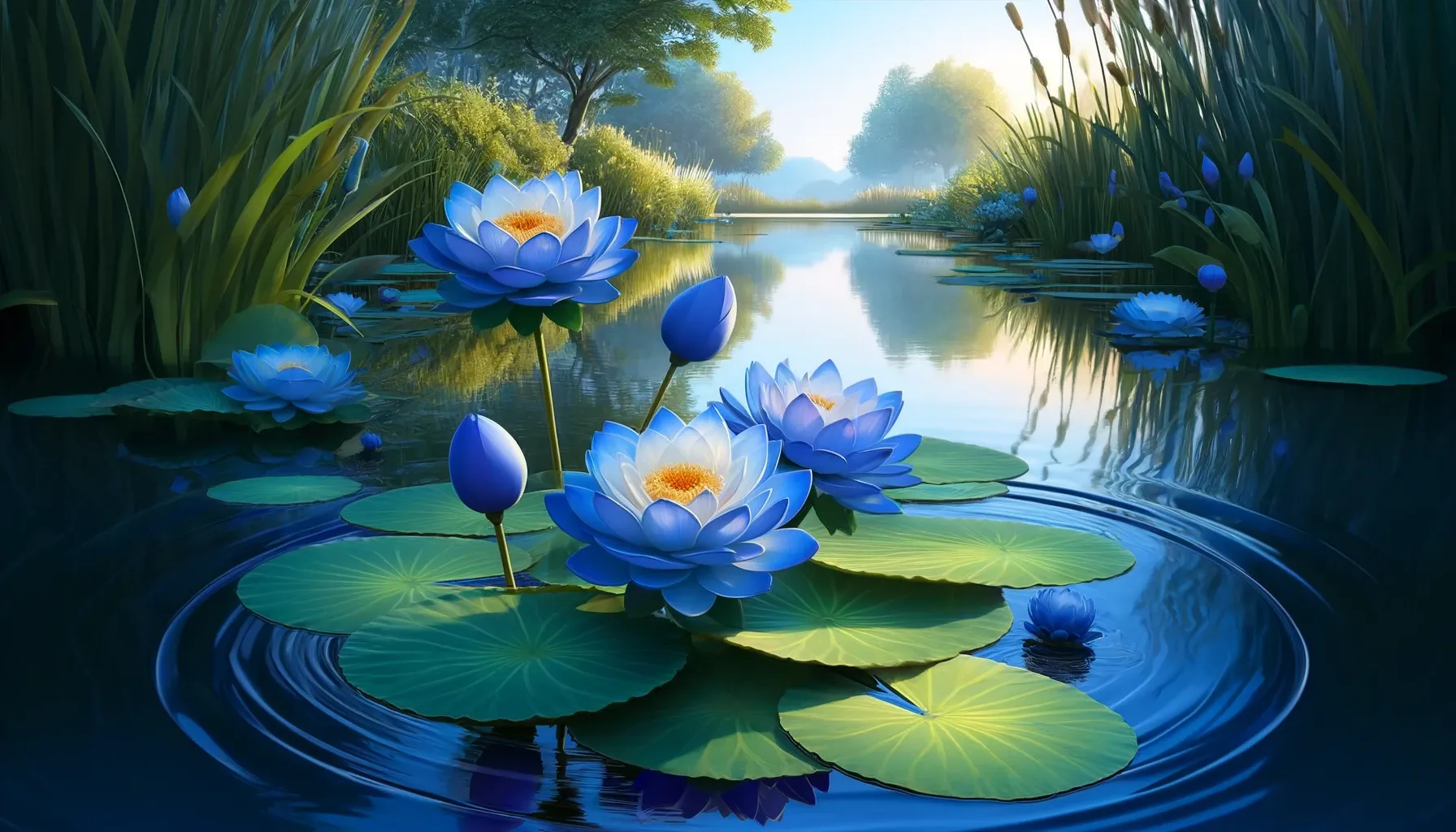Overview of the Blue Lotus Flower
The blue lotus flower, also known as the blue Egyptian lotus or blue water lily, is a captivating plant revered for its spiritual and medicinal properties. Scientifically named Nymphaea caerulea, this sacred flower has been utilized for thousands of years across various cultures, most notably in ancient Egypt. The blue lotus is admired not only for its stunning visual appeal but also for its psychoactive and calming effects, making it a popular natural remedy.

Historical Significance in Ancient Cultures
In ancient Egyptian culture, these blue flowers held profound symbolic meaning. This spiritual flower was closely associated with the sun god, Ra, and was believed to represent rebirth and regeneration. The flower’s daily blooming cycle, opening with the sunrise and closing at dusk, reinforced this symbolism. Moreover, blue lotus flowers were often depicted in Egyptian art and were integral to religious rituals and ceremonies. The flower’s ritualistic use and psychoactive properties made it a favored component in spiritual practices, where it was consumed to induce trance-like states and enhance meditation.
Purpose and Scope of the Article
This article aims to provide a comprehensive exploration of the blue lotus flower, detailing its botanical characteristics, historical context, chemical composition, benefits, side effects, legal status, and various consumption methods. It will also compare blue lotus to alternative herbs and address frequently asked questions. Through this in-depth analysis, readers will gain a thorough understanding of the blue lotus, its traditional uses, and its relevance in modern times. This guide is intended for those interested in the potential benefits and risks associated with consuming blue lotus flower and those seeking to incorporate this ancient plant into their wellness routines responsibly.
What is Blue Lotus Flower?
Botanical Classification and Description
The blue lotus flower, also known as the blue Egyptian lotus or blue water lily, belongs to the Nymphaeaceae family. Scientifically named Nymphaea caerulea, this aquatic plant is renowned for its vibrant blue petals and golden center. The flower floats gracefully on water surfaces, with leaves that can spread up to 40 centimeters in diameter. Its unique beauty and aromatic fragrance have made it a prized ornamental plant as well as a subject of historical significance.
Geographic Distribution and Habitat
The blue lotus thrives in freshwater environments such as ponds, lakes, and slow-moving rivers. Native to the Nile Delta in Egypt, the plant has also been found in parts of East Africa and Southeast Asia. Ideal conditions for the blue lotus include warm temperatures and abundant sunlight, which support its daily blooming cycle. In optimal habitats, the plant’s rhizomes anchor in muddy substrates, allowing the leaves and flowers to float on the water's surface.
Historical Uses in Ancient Egypt and Asia
In ancient Egypt, the blue lotus was more than just an ornamental flower; it was a sacred symbol deeply embedded in the culture and religion. The Egyptians revered the blue lotus as a representation of the sun god, Ra, and associated it with rebirth and the afterlife. This sacred flower frequently appeared in Egyptian art, adorning tombs, temples, and papyrus scrolls. It played a significant role in religious ceremonies and was often used in rituals aimed at achieving spiritual enlightenment.
Apart from its symbolic value, the blue lotus was also consumed for its psychoactive properties. Ancient texts suggest that the Egyptians used the flower to prepare a form of blue lotus tea, which was believed to induce mild euphoria and enhance mental clarity. The psychoactive effects were attributed to the presence of compounds such as apomorphine and nuciferine. Consuming blue lotus flowers became a part of various religious and social practices, providing both spiritual and medicinal benefits.
In Asia, particularly in regions like India and Thailand, the blue lotus was similarly revered. It was incorporated into traditional medicine and spiritual practices. The flower’s calming and antipsychotic properties made it a valuable component in treatments for mental health issues and in rituals aimed at fostering a connection with the divine.
The historical significance of the blue lotus across different cultures underscores its enduring legacy as a sacred flower with profound spiritual and medicinal applications.
Chemical Composition of Blue Lotus

Key Compounds: Apomorphine and Nuciferine
The blue lotus flower (Nymphaea caerulea), also known as the blue Egyptian lotus or blue water lily, is celebrated not only for its aesthetic beauty but also for its complex chemical composition. The primary psychoactive compounds found in blue lotus are apomorphine and nuciferine.
- Apomorphine: This compound is a dopamine agonist, meaning it stimulates dopamine receptors in the brain. Apomorphine has a dual role as both a psychoactive substance and an antipsychotic drug. Its interaction with dopamine receptors can induce feelings of euphoria, making it a key ingredient in the flower's entheogenic properties.
- Nuciferine: Nuciferine is another significant alkaloid found in blue lotus. It acts as a mild sedative and has potential antipsychotic effects. By binding to various neurotransmitter receptors, nuciferine contributes to the calming and mood-stabilizing effects reported by users of blue lotus products.
Psychoactive Properties and Their Effects
Blue lotus is classified as a psychoactive plant due to the mind-altering effects induced by its key compounds. These effects are primarily attributed to the interaction of apomorphine and nuciferine with the brain’s neurochemical systems, leading to mood enhancement.
- Euphoria and Altered Consciousness: Consuming blue lotus flower, especially in the form of blue lotus tea or other concentrated preparations, can lead to a mild euphoria. This state is often described as a peaceful, uplifting feeling, conducive to meditation and spiritual practices.
- Calming and Sedative Effects: The nuciferine in blue lotus acts on neurotransmitter pathways to promote relaxation. This sedative property is beneficial for reducing anxiety and stress, which aligns with the flower’s historical use in ancient Egyptian culture for mental health and spiritual balance.
Comparative Analysis with Other Psychoactive Plants
When compared to other psychoactive plants, blue lotus exhibits unique properties that distinguish it from more potent substances.
- Mild Psychoactivity: Unlike controlled substances such as psilocybin mushrooms or peyote, the psychoactive effects of blue lotus are relatively mild. This makes it a safer option for those seeking a gentle introduction to psychoactive plants without the risk of severe psychological effects.
- Historical and Cultural Context: The use of blue lotus in ancient Egypt as a sacred flower dedicated to the sun god Ra highlights its cultural and spiritual significance. This historical backdrop sets it apart from other psychoactive plants primarily used for recreational purposes.
- Accessibility and Legal Status: Blue lotus products, such as blue lotus tea and extracts, are widely available and legal in most regions, unlike many other psychoactive plants that are restricted or controlled substances.
The chemical composition of blue lotus, particularly the presence of apomorphine and nuciferine, underpins its psychoactive properties and traditional uses. This chapter elucidates how these compounds contribute to the flower’s unique effects as a natural sedative, positioning blue lotus as a fascinating plant and subject of both historical reverence and modern exploration.
Benefits of Blue Lotus Flower

Mind-Altering Properties
Spiritual and Religious Use as an Entheogen
The blue lotus flower has long been revered for its mind-altering properties, particularly in spiritual and religious contexts. As an entheogen, the blue Egyptian lotus was used in ancient Egypt to induce trance-like states and enhance spiritual experiences. Consuming blue lotus flower, often in the form of blue lotus tea, helped practitioners connect with the divine and achieve a higher state of consciousness. The psychoactive compounds, apomorphine and nuciferine, facilitate these experiences by stimulating dopamine receptors, which can lead to a sense of euphoria and heightened spiritual awareness.
Modern Recreational Use
In contemporary settings, the blue lotus has found a place in recreational use due to its mild psychoactive effects. Modern users often seek the gentle euphoria and relaxation that come from consuming blue lotus products. This use is typically facilitated through various methods, including blue lotus tea, tinctures, and extracts. The psychoactive plant’s appeal lies in its ability to provide a soothing, almost meditative state without the intensity associated with more potent psychoactive substances elsewhere.
Calming and Anti-Anxiety Effects
Traditional Use for Anxiety Relief
Historically, the blue water lily has been utilized for its calming effects. In ancient Egyptian culture, the sacred blue lily was used to alleviate symptoms of anxiety and stress. The soothing properties of the flower were well-regarded, making it a common remedy for promoting mental health and emotional well-being.
Modern Anecdotal Evidence
Today, many individuals turn to blue lotus products as a natural alternative to synthetic anxiolytics. Users report that consuming blue lotus flower can help reduce feelings of anxiety and even promote sleep and a sense of tranquility. This calming effect is largely attributed to nuciferine, which acts as a mild sedative, helping to stabilize mood and ease mental tension. While scientific studies are limited, anecdotal evidence supports the flower's efficacy in managing anxiety and stress.
Sleep and Lucid Dream Induction
Historical Use for Insomnia
The use of blue lotus for sleep dates back to ancient Egypt, where it was employed as a remedy for insomnia. The flower's sedative properties were harnessed to help individuals achieve restful sleep. By consuming blue lotus flower in various forms, including teas and infusions, the ancient Egyptians were able to address sleep disturbances and improve their overall sleep quality.
Mechanism of Action for Lucid Dreaming
Beyond its use as a sleep aid, the blue lotus is also known for its potential to induce lucid dreams. This phenomenon occurs when a person becomes aware that they are dreaming and can often exert some control over the dream narrative. The psychoactive compounds in the blue lotus flower, particularly apomorphine, play a crucial role in facilitating lucid dreaming by enhancing dream vividness and awareness. This has made blue lotus tea and other preparations popular among those seeking to explore the depths of their subconscious mind during sleep.
Aphrodisiac Properties
Ancient Egyptian Practices
In ancient Egypt, the blue lotus flower was celebrated not only for its spiritual and calming properties but also for its aphrodisiac effects. The flower was often used in romantic and fertility rituals, believed to enhance sexual desire and even sexual performance. This use is well-documented in Egyptian art and literature, where the blue lotus is frequently depicted in intimate and sensual contexts.
Potential Role in Treating Erectile Dysfunction
Modern interest in the blue lotus as an aphrodisiac continues, with some studies suggesting that its key compounds may have beneficial effects on sexual health. Apomorphine, in particular, has shown potential in treating erectile dysfunction by enhancing dopamine activity, which is crucial for sexual arousal and performance. Although more research is needed, the historical use and preliminary evidence support the blue lotus flower's role as a natural aid in sexual health.
The benefits of the blue lotus flower are extensive, spanning from its mind-altering properties and calming effects to its use as a sleep aid and aphrodisiac. Its rich history and multifaceted applications make it a valuable plant for both ancient and modern users seeking natural and herbal remedies for mental and emotional well-being.
Side Effects and Safety Concerns
Documented Adverse Reactions
Case Studies of Negative Effects
Despite its historical and contemporary uses, the blue lotus flower (Nymphaea caerulea) can cause several adverse reactions. There have been documented cases of negative effects following the consumption of blue lotus products. These effects can range from mild to severe, depending on the individual's sensitivity and the amount consumed.
Symptoms and Duration of Side Effects
Common side effects reported include:
- Confusion and Disorientation: Some users have experienced confusion and a lack of clarity.
- Chest Pain: Instances of chest pain have been noted, which can be alarming and necessitate medical attention.
- Paranoia and Anxiety: Although blue lotus is often used to alleviate anxiety, in some cases, it can exacerbate these feelings.
- Drowsiness and Slurred Speech: The sedative properties of the flower can lead to excessive drowsiness and impaired speech.
- Paranoia: Increased feelings of paranoia can occur in some users.
The duration of these symptoms can vary, but they typically resolve within a few hours without the need for medical intervention.
Interaction with Medications
Dopamine-Related Drugs
The presence of apomorphine, a dopamine agonist, in blue lotus can interact with medications that affect dopamine levels. This includes drugs used to treat Parkinson's disease and certain antipsychotic medications. These interactions can amplify or diminish the effects of the medications, leading to unpredictable and potentially dangerous outcomes.
Potential Drug Interactions
Blue lotus may also interact with other types of medications, including:
- Antidepressants: The calming effects of blue lotus can interfere with the action of antidepressants, potentially leading to an imbalance in neurotransmitter levels.
- Sedatives and Alcohol: Combining blue lotus with other sedatives or alcohol can enhance its depressant effects, leading to increased drowsiness and a higher risk of accidents.
Safety Guidelines for Use
Recommended Dosages
To minimize the risk of adverse effects, it is crucial to adhere to recommended dosages. For most individuals, consuming blue lotus flower in moderate amounts, such as a mild tea, is generally safe. However, higher doses, particularly when consumed as extracts or in smoking blends, can increase the likelihood of side effects.
- Tea: Steep 5 grams of dried blue lotus flowers in hot water for 5-10 minutes. This preparation is considered mild and less likely to cause severe side effects.
- Extracts and Tinctures: Follow the manufacturer’s dosage recommendations, typically a few drops diluted in water or under the tongue.
Populations at Risk
Certain populations should exercise caution when considering the use of blue lotus:
- Pregnant and Nursing Women: There is limited research on the effects of blue lotus on pregnancy and lactation, making it advisable to avoid its use during these periods.
- Individuals with Heart Conditions: Due to the potential for chest pain and cardiovascular effects, those with existing heart conditions should avoid blue lotus.
- Mental Health Disorders: People with mental health conditions, particularly those involving anxiety and paranoia, may find their symptoms exacerbated by blue lotus.
While blue lotus flowers have been revered for their spiritual and calming properties, it is essential to approach their use with caution. Understanding the potential side effects, drug interactions, and recommended dosages can help ensure safe consumption. By adhering to these guidelines, individuals can enjoy the benefits of this sacred flower while minimizing the risks associated with its use.
Common Forms and Consumption Methods

Blue Lotus Tea
One of the most popular ways to consume blue lotus flower is through the blue lotus tea effects. Blue lotus tea is made by steeping the dried petals or buds of the blue Egyptian lotus in hot water. This method releases the plant's psychoactive compounds, primarily apomorphine and nuciferine, which can induce mild euphoria and relaxation. To prepare blue lotus tea:
- Ingredients:
- 5 grams of dried blue lotus flowers
- 250 ml of hot water (not boiling)
- Instructions:
- Place the dried flowers in a tea infuser or directly into a cup.
- Pour hot water over the flowers and let them steep for 5-10 minutes.
- Strain the flowers (if not using an infuser) and enjoy.
Smoking and Vaping Blends
Another common method of consuming blue lotus flower is by smoking or vaping the dried flower petals. This method provides a more immediate effect compared to tea. Smoking blue lotus can enhance its psychoactive properties, offering a quicker onset of euphoria and relaxation. Users typically blend blue lotus with other herbs to create a balanced smoking experience. For vaping, ensure that the device is compatible with herbal materials.
- Preparation for Smoking:
- Grind the dried blue lotus petals.
- Mix with other herbs if desired.
- Roll into a cigarette or use a pipe.
- Preparation for Vaping:
- Use a vaporizer designed for dry herbs.
- Load the ground petals into the chamber.
- Set the vaporizer to the recommended temperature and inhale.
Essential Oils and Extracts
Blue lotus essential oil and extracts are concentrated forms of the plant, offering potent effects. These products are often used in aromatherapy or topical applications rather than for ingestion. The essential oil can be diffused to create a calming atmosphere, while extracts can be diluted and applied to the skin for their relaxing properties.
- Essential Oil:
- Add a few drops to a diffuser with water.
- Use in massage oils by diluting with a carrier oil.
- Extracts:
- Follow the manufacturer's instructions for dilution and application.
- Avoid direct ingestion unless specified as safe for consumption.
Alcoholic Beverages Infused with Blue Lotus
Historically, the ancient Egyptians infused blue lotus flowers in wine to create a mildly psychoactive drink. This practice continues today with modern variations, where the flowers are steeped in wine or other alcoholic beverages to enhance their relaxing effects.
- Preparation:
- Choose a light wine or alcoholic beverage.
- Add a handful of dried blue lotus flowers to the bottle.
- Let the mixture sit for 1-2 weeks, shaking occasionally.
- Strain the flowers before serving.
Summary
Blue lotus, or blue water lily, offers various consumption methods, each providing unique benefits. From blue lotus tea to smoking blends, essential oils, and infused beverages, the sacred blue lily's versatility caters to different preferences and desired effects. Whether seeking relaxation, mild euphoria, or a spiritual experience, consuming blue lotus flower in its various forms allows users to harness its historical and psychoactive properties effectively.
Alternatives to Blue Lotus
Herbs for Lucid Dreaming
Mugwort
Mugwort (Artemisia vulgaris) is a well-known medicinal herb, used to enhance lucid dreaming. Like the blue lotus flower, mugwort has a rich history in various cultures for its psychoactive properties. When consumed, mugwort can help induce vivid dreams and improve dream recall, making it a popular alternative for those interested in exploring their subconscious without the psychoactive intensity of blue lotus.
- Preparation: Mugwort can be used in teas, smoking blends, or placed under the pillow as a sleep aid.
- Tea Recipe:
- 1 teaspoon of dried mugwort leaves
- 250 ml of hot water
- Steep for 5-10 minutes, strain, and drink before bedtime.
Other Herbs and Their Effects
Several other herbs can also be used to promote lucid dreaming and enhance dream experiences:
- Calea Zacatechichi: Known as the "Dream Herb," Calea Zacatechichi is traditionally used by the Chontal people of Mexico to enhance dream clarity and promote lucid dreaming.
- Valerian Root: Although primarily used as a sleep aid, valerian root can also improve dream vividness and recall.
- Passionflower: This herb has mild sedative effects and can enhance the dream experience, making it a good alternative for those seeking gentle dream enhancement.
Calming Herbs and Sleep Aids
Catnip, Chamomile, and Lavender
For those looking for calming effects and improved sleep without the psychoactive properties of blue lotus, several herbs offer excellent alternatives:
- Catnip: Known for its calming effects on cats, catnip (Nepeta cataria) also has mild sedative properties for humans. It can help reduce anxiety and promote restful sleep.
- Chamomile: Chamomile (Matricaria chamomilla) is a popular herbal remedy for anxiety and insomnia. Its gentle sedative effects make it a staple in bedtime teas.
- Lavender: Lavender (Lavandula angustifolia) is renowned for its soothing aroma and calming effects. It can be used in teas, essential oils, or sachets to promote relaxation and better sleep.
Herbal Teas and Blends for Relaxation
Combining various herbs can create powerful blends for relaxation and improved sleep. Here are a few recipes:
- Sweet Slumber Tea:
- 1 teaspoon dried chamomile flowers
- 1 teaspoon dried lavender flowers
- 1 teaspoon dried catnip leaves
- 250 ml hot water
- Steep for 5-10 minutes, strain, and enjoy before bedtime.
- Calm Mind Blend:
- 1 teaspoon dried passionflower
- 1 teaspoon dried lemon balm
- 1 teaspoon dried valerian root
- 250 ml hot water
- Steep for 10-15 minutes, strain, and drink in the evening to unwind.
These herbal alternatives provide a variety of options for those seeking the benefits of blue lotus flowers without the potential psychoactive effects. Whether for lucid dreaming or relaxation, these herbs can be seamlessly integrated into daily routines to promote mental health and well-being.
FAQs about Blue Lotus Flower
What is the Blue Lotus Flower?
The blue lotus flower, also known as the blue Egyptian lotus or blue water lily, is a sacred flower with deep historical roots in ancient Egyptian culture. It is renowned for its psychoactive and medicinal properties, often used in spiritual ceremonies and traditional medicine. This psychoactive plant is recognized for its vibrant blue petals and distinctive fragrance.
What are the benefits of Blue Lotus Flower?
The benefits of the blue lotus flower are multifaceted:
- Mind-Altering Properties: The flower contains apomorphine and nuciferine, which can induce mild euphoria and enhance spiritual experiences.
- Calming Effects: It has been traditionally used to reduce anxiety and stress, promoting mental health.
- Sleep Aid: The flower can help improve sleep quality and induce lucid dreams.
- Aphrodisiac: Historically, it has been used to enhance sexual desire and treat erectile dysfunction.
Are there any side effects of using Blue Lotus?
Yes, consuming blue lotus flower can have side effects, especially in high doses:
- Confusion and Disorientation
- Chest Pain
- Paranoia and Anxiety
- Drowsiness and Slurred Speech
These symptoms are usually mild and temporary but can be severe in some cases. It is important to use blue lotus products cautiously.
Is Blue Lotus legal to use?
In the United States, blue lotus is not classified as a controlled substance, making it legal to grow, sell, and possess in most states. However, it is not approved by the FDA for human consumption. Louisiana is an exception, where blue lotus is regulated as a controlled substance. Internationally, the legal status varies, so it is essential to check local regulations before purchasing or using blue lotus products.
How is Blue Lotus typically consumed?
There are several ways to consume blue lotus flower:
- Blue Lotus Tea: Steep dried petals in hot water for 5-10 minutes.
- Smoking or Vaping: Use dried petals in smoking blends or vaporizers.
- Essential Oils and Extracts: Used in aromatherapy or diluted for topical application.
- Alcoholic Beverages: Infuse dried flowers in wine or other alcoholic drinks for a mildly psychoactive effect.
What are the best alternatives to Blue Lotus for sleep and relaxation?
Several herbs can serve as alternatives to blue lotus for sleep and relaxation:
- Mugwort: Enhances lucid dreaming and dream recall.
- Chamomile: Popular for its calming effects and ability to improve sleep quality.
- Lavender: Known for its soothing aroma and relaxation benefits.
- Valerian Root: Used to promote restful sleep and reduce anxiety.
These FAQs address common questions about the blue lotus flower, providing essential information for those interested in its benefits and uses.
Conclusion

The blue lotus flower, also known as the blue Egyptian lotus or blue water lily, is a plant of significant historical and cultural importance, particularly in ancient Egyptian culture where it was associated with the sun god and considered a sacred flower. This psychoactive plant is revered for its various benefits, including its mind-altering properties, calming effects, and use as an aphrodisiac. The primary active compounds, apomorphine and nuciferine, contribute to its effects on mental health and well-being.
- Historical Significance: Integral to ancient Egyptian rituals and symbolism.
- Chemical Composition: Contains apomorphine and nuciferine, contributing to its psychoactive and calming properties.
- Benefits: Used for inducing euphoria, reducing anxiety, aiding sleep, and enhancing sexual health.
- Consumption Methods: Commonly consumed as tea, smoked, vaped, or used in essential oils and alcoholic infusions.
- Legal Status: Generally legal in the United States except in Louisiana, with varying regulations internationally.
Final Thoughts on the Use of Blue Lotus
The blue lotus flower's enduring legacy as a sacred and medicinal plant underscores its versatility and appeal. Its psychoactive properties have made it a valuable tool for spiritual and recreational use, while its calming effects provide natural relief for anxiety and sleep disorders. However, the potential side effects and interactions with medications necessitate cautious and informed use. The lack of FDA approval for human consumption further highlights the need for consumers to seek reputable sources and adhere to recommended dosages.
Recommendations for Safe Consumption
For those interested in exploring the benefits of blue lotus products, several guidelines can help ensure safe and effective use:
- Start with Small Doses: Begin with lower doses to assess individual tolerance and response.
- Consult Healthcare Providers: Especially important for individuals with pre-existing health conditions or those taking other medications.
- Purchase from Reputable Sources: Ensure products are sourced from credible vendors to avoid contamination or mislabeling.
- Adhere to Legal Regulations: Be aware of the legal status in your region and comply with local laws.
- Monitor for Side Effects: Be vigilant about any adverse reactions, such as chest pain or heightened anxiety, and seek medical advice if necessary.
The blue lotus flower offers a unique blend of historical mystique and modern appeal, bridging ancient traditions with contemporary wellness practices. By following safe consumption practices, individuals can enjoy the myriad health benefits, of this remarkable plant while minimizing potential risks.
